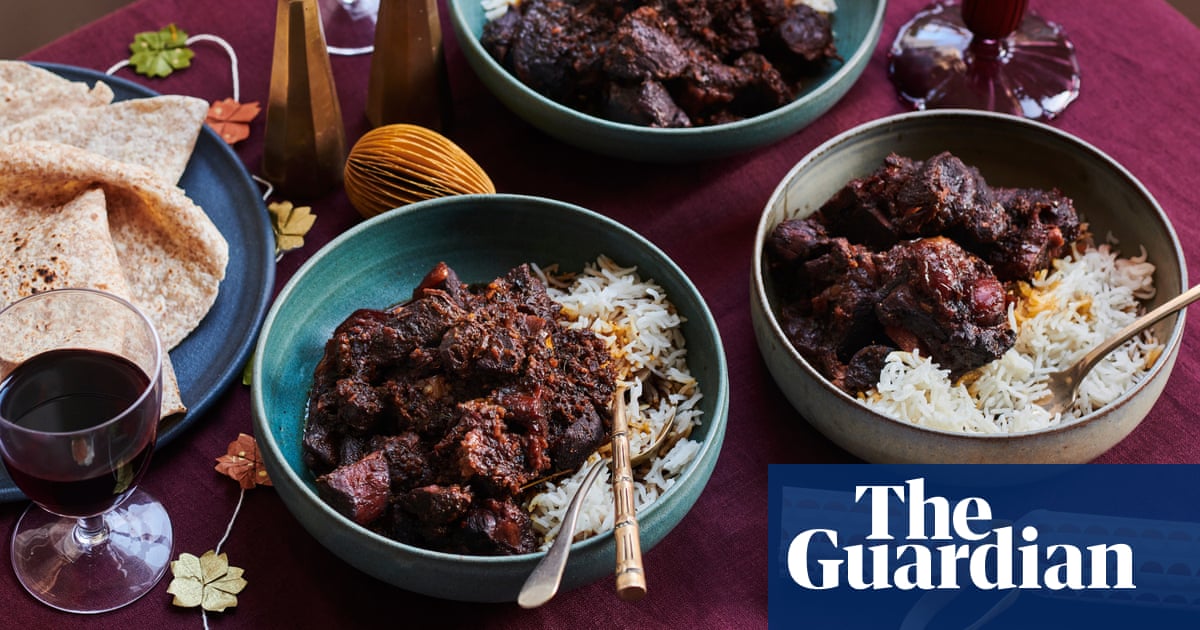An ancestral Guyanese stew often made at Christmas with a rich herb and spice mix for extra depth
One of the largest remaining populations of indigenous Amerindian tribes in the English-speaking Caribbean is found in Guyana, where the legacies of the Warrau, Arawak and Carib can be seen to this day. Among the most famous of these is the cultivation and consumption of cassava root, after the Arawak developed a way to turn the prussic acid in cassava juice into a non-poisonous vinegar by cooking it. They called this cassareep and, together with local spices and pepper, it forms the basis of Guyanese pepperpot, a slow-cooked, jet-black stew that’s usually reserved for Christmas, when it’s traditionally paired with plait bread. It’s quite different from the pepperpot of other Caribbean islands, or even the African-American version, because the cassareep brings a deep, rich, slightly tangy sweetness to a gently peppery sauce that gets progressively thicker over time and that sticks to bread like metal to magnets. Traditionally, pepperpot was made with whatever meat the native peoples could catch, including deer, hogs and even wild rodents; today, though, unless you venture deep into the Guyanese interior, you’re more likely to find it made with more recognisable meats. There’s essentially no replacement for cassareep, so look for it in Caribbean and African food stores, or online. It can be an acquired taste, especially if it’s your first time; the more you use, the thicker and deeper browny-black the sauce will be.
These recipes are edited extracts from East Winds: Recipes, History and Tales from the Hidden Caribbean, by Riaz Phillips, published by DK at £25. To order a copy for £22, go to guardianbookshop.com Continue reading...
http://dlvr.it/Szk05r
One of the largest remaining populations of indigenous Amerindian tribes in the English-speaking Caribbean is found in Guyana, where the legacies of the Warrau, Arawak and Carib can be seen to this day. Among the most famous of these is the cultivation and consumption of cassava root, after the Arawak developed a way to turn the prussic acid in cassava juice into a non-poisonous vinegar by cooking it. They called this cassareep and, together with local spices and pepper, it forms the basis of Guyanese pepperpot, a slow-cooked, jet-black stew that’s usually reserved for Christmas, when it’s traditionally paired with plait bread. It’s quite different from the pepperpot of other Caribbean islands, or even the African-American version, because the cassareep brings a deep, rich, slightly tangy sweetness to a gently peppery sauce that gets progressively thicker over time and that sticks to bread like metal to magnets. Traditionally, pepperpot was made with whatever meat the native peoples could catch, including deer, hogs and even wild rodents; today, though, unless you venture deep into the Guyanese interior, you’re more likely to find it made with more recognisable meats. There’s essentially no replacement for cassareep, so look for it in Caribbean and African food stores, or online. It can be an acquired taste, especially if it’s your first time; the more you use, the thicker and deeper browny-black the sauce will be.
These recipes are edited extracts from East Winds: Recipes, History and Tales from the Hidden Caribbean, by Riaz Phillips, published by DK at £25. To order a copy for £22, go to guardianbookshop.com Continue reading...
http://dlvr.it/Szk05r


Post a Comment